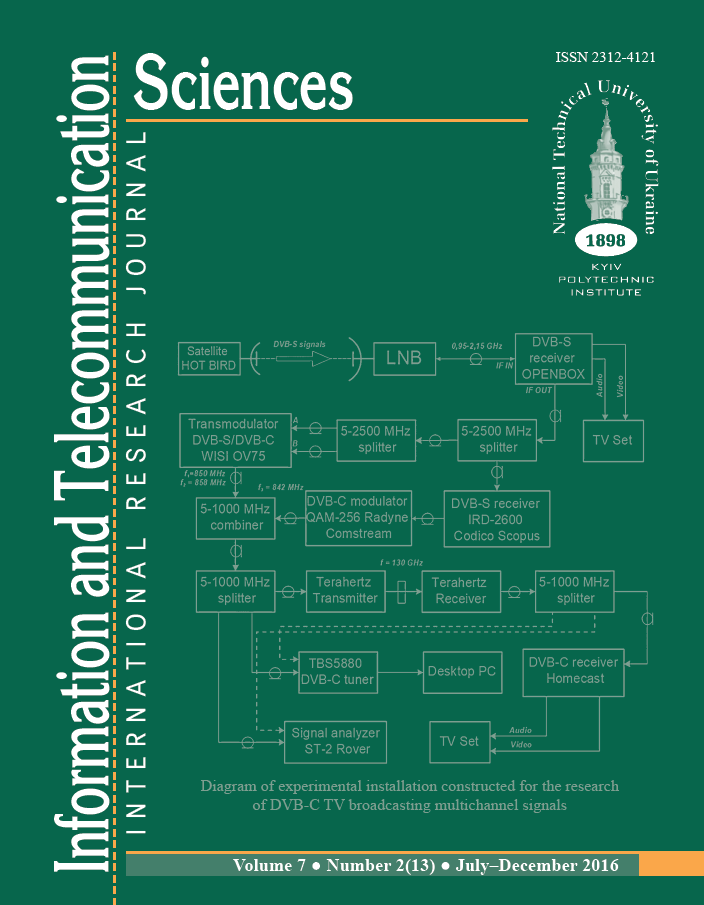HISTOGRAM-BASED METHOD FOR NO-REFERENCE MEASUREMENT OF GENERALIZED CONTRAST OF COMPLEX IMAGES
DOI:
https://doi.org/10.20535/2411-2976.22016.35-45Keywords:
image quality, contrast metrics, no-reference, complex image, generalized contrast, contrast kernel, histogramAbstract
Background. Nowadays the task of automatically measuring of image quality in real time is extremely relevant for the vast majority of practical applications. No-reference quantitative assessment of image quality is one of the most pressing and difficult problems of image processing. Generalized contrast is the most important quantitative characteristic which determines the objective quality of the image. Currently, the development of new effective methods of no-reference measuring of generalized contrast for complex image in automatic mode with the level of computing costs, which are acceptable to implement the processing in real time, is one of the most urgent tasks of image preprocessing.
Objective. Development of new histogram-based method for no-reference measurement of generalized contrast of complex (multi-element) images based on the average contrast of image elements (objects and background) for different definitions of contrast kernel.
Methods. Analysis of known approaches to measurement of a local contrast of the image elements, of known methods of the quantitative assessment of generalized contrast of complex images as well as of the experimental research results for a series of complex real and test images allowed revealing inherent patterns (accordance to basic requirements to the definition of contrast, the nature and the dynamic of contrast changes at the linear transformations of the brightness scale), which are manifested depending on the use of the different definitions of the contrast kernels and the metrics of generalized contrast of
images.
Results. No-reference contrast metrics for the histogram-based measuring of generalized contrast of complex images based on the average contrast of image elements for different definitions of contrast kernel is proposed.
Conclusions. Proposed no-reference metrics based on the average contrast of image elements for proposed contrast kernels allow providing accurate quantitative assessment (measurement) of generalized contrast of the real complex images and enable to evaluate (predict) with reasonable accuracy the perceived image quality at carrying out of subjective (qualitative) expert estimates.
References
Z. Wang, A. C. Bovik and L. Lu, Why is image quality assessment so difficult? In IEEE International Conference on Acoustics, Speech, and Signal Processing, volume 4, pages IV–3313 –IV–3316, May 2002.
Z. Wang and A.C. Bovik, Modern Image Quality Assessment, Morgan and Claypool Publishing Company, New York, 2006.
E. Peli (Oct 1990). "Contrast in Complex Images" (PDF). Journal of the Optical Society of America A. 7 (10): 2032–2040. doi:10.1364/JOSAA.7.002032.
H. R. Sheikh and A. C. Bovik, “Image information and visual quality”, Image Processing, IEEE Transactions on, vol. 15, no. 2, pp. 430–444, 2006.
Z. Wang, A. C. Bovik, H. R. Sheikh, and E. P. Simoncelli, Image quality assessment: From error visibility to structural similarity. IEEE Trans. Image Process, 13:600– 612, 2004.
R. C. Gonzalez, R. E.Woods, Digital Image Processing, Prentice Hall, 2002.
“Methodology for the subjective assessment of the quality of television pictures”, Recommendation ITU-R BT.500-10, 1998.
Z. Wang, H. R. Sheikh, A. C. Bovik, B. Furht, O. Marqure, "Objective video quality assessment" in The Handbook of Video Databases: Design and Applications, vol. ch. 41, pp. 1041-1078, Sept 2003, The University of Texas at Austin, CRC Press.
M. Shahid, A. Rossholm, B. Lövström, H.-J.Zepernick, No-reference image and video quality assessment: a classification and review of recent approaches, EURASIP Journal on Image and Video Processing, 2014, DOI: 10.1186/1687-5281-2014-40.
Z. Wang and A. Bovik, “A universal image quality index”, Signal Processing Letters, IEEE, vol. 9, no. 3, pp. 81–84, Mar 2002.
William K. Pratt Digital Image Processing: PIKS Inside, Third Edition Copyright © 2001 John Wiley & Sons, Inc. ISBNs: 0-471-37407-5.
R. Vorobel Image contrast and its connection with fuzzy logic / Roman Vorobel, Olena Berehulyak // Proceedings of IWIM 2007, CTU in Prague. - p.104-110.
R. A. Vorobel, The logarithmic image processing / Roman A. Vorobel. - Kyiv: Naukova Dumka, 2012. - 231 p. - (The "Science"). - Ref .: s.214-227 - In Ukrainian. I'm from. - ISBN 978-966-00-1242-4.
Pierre Bouguer. Traité d’optique sur la gradation de la lumière. Paris, 1760.
Weber, E. H. (1834, 1996). De tactu. Annotationes anatomicae et physiologicae. Koehler, Leipzig (1834). Transl. H. E. Ross and D. J. Murray (Eds) (1996). E. H. Weber on the Tactile Senses, 2nd edn. Erlbaum (UK), Taylor and Francis, Hove, UK.
P.E. King-Smith, J.J. Kulikowski, Pattern and flicker detection analyzed by subthreshold summation, Journal of Physiology, 249, 519-548, (1975).
Burkhardt DA, Gottesman J, Kersten D, Legge GE. Symmetry and constancy in the perception of negative and positive luminance contrast, Journal of the Optical Society of America A, 1, 309-316, (1984).
P. Whittle, Increments and decrements: luminance discrimination, Vision Res., 26, 1677-1691, (1986).
Sanders, Mark S.; McCormick, Ernest J. (January 1, 1993). Human Factors in Engineering and Design (7th ed.). New York: McGraw-Hill. p. 704. ISBN 978-0070549012.
R. A. Vorobel, Digital image processing based on the theory of contrast / Vorobel R. A. The dissertation for the degree of Doctor of Science: 05.13. Lviv, 1999. -369p (In Ukrainian).
V. F. Nesteruk, N.N. Porfyryeva, Contrasting law of light perception // Optics and Spectroscopy. – 1970. – vol. ХХІХ, no. 6. – pp. 1138 – 1143 (In Russian).
Vorobel R.A. Perception of the subject images and quantitative evaluation of their contrast based on the linear description of evaluative elements of contrast // Reports of the Ukrainian Academy of Sciences. No.9, pp.103-108, 1998 (In Ukrainian).
E.S. Yelmanova Quantitative Assessment of Contrast of the Image Elements // Academic Journals & Conferences of Lviv Polytechnic National University. Vol 818, No 2015, pp. 69-75 (In Ukrainian).
Haralick RM, Shanmuga K, Dinstein / Textural features for image classification. IEEE Transactions on Systems Man and Cybernetics SMC3(6):610 - 621 - December 1973.
R.M Haralick. Statistical and structural approaches to texture. Proceedings of the IEEE, 67:786–804, 1979.
Public-Domain Test Images for Homework’s and Projects, http://homepages.cae.wisc.edu/ /~ /images/

